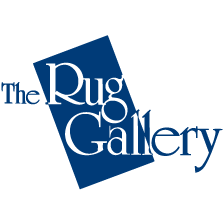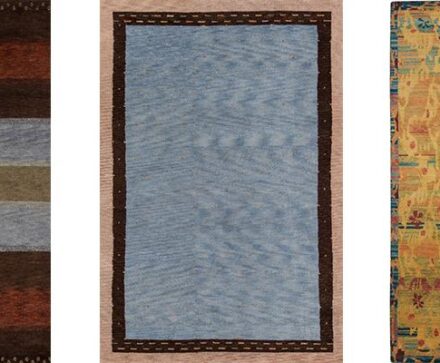What Is a Transitional Rug?
Transitional rugs are a type of rug that is becoming more and more popular in the marketplace. In this podcast, learn about what a transitional rug is and how it’s different from other types of rugs, like traditional rugs and modern rugs.
John Maher: Welcome to the Rug Gallery with Sam Presnell. The Rug Gallery is an oriental rug company and carpet store in Cincinnati Ohio. I’m John Maher and I’m here with the owner of the Rug Gallery, Sam Presnell. Hi, Sam.
Sam Presnell: Hey, John.
Transitional Rugs Defined
John: So today we’ll be talking about transitional rugs. So Sam, what are transitional rugs?
Sam: Transitional rugs I think are things that I would describe as taking over the traditional basic rugs. In that they are based in traditional design. You’ll see elements in transitional rugs that are definitely from old rugs or textiles or tapestries and things like that. And they’ve been enhanced or they’ve been simplified. They’ve had a border taken off, or the designs are blown up to a whole other level of design, which can encompass the whole rug in some rugs I’ve seen. Those are what we would call transitional. Also, I’m also seeing where they’ll take a rug that looks old and they’ll take the border off of it and they’ll take some of the design off and actually weave them and make them this way. If you can imagine you take a design and erase some of the pattern to it and when you look at it from a little bit of a distance, you start seeing, “Hey, it’s missing the design, it looks worn, it looks antique,” or something like that. I think that’s also what we would call transitional as well.
Types of Transitional Rugs
John: Okay. What are some different types of transitional rugs? I know you just talked about a couple of different styles there.
Sam: Yeah. What I’m thinking about is how many different ways you can buy a rug [and how rugs are made]. You can buy a rug that’s machine woven. It can be machine woven in wool, it can be machine woven in a synthetic fiber of some sort, and there’s all different types of those. They can tuft it, which is basically like hooking a rug or punching a design into a canvas cloth and then cutting it or keeping it looped or whatever you want to do, like a hooked rug would be. We have hand-tufted rugs, and then you have printed rugs. Basically you take a carpet and you have a printing press, basically some of these mills actually employ these huge machines that can print designs with multiple colors on top of it as well.
John: So you would start with sort of a base, like a white rug or something like that, and they would put color on top of it?
Sam: Exactly. We call it a base color. Basically, it’s usually a greyish-white color. Then they print the design on top of it that they want to put into it.
John: Interesting.
Sam: Then you have the hand-knotted rugs, which actually somebody tied every single knot of that rug, one at a time. Those are the many different types of transitional rugs as far as how they’re made. Then those designs, as I went into before, what they’re doing with traditional rugs and modifying them is what picks up a transitional rug.
Colors for Transitional Rugs
John: Okay. What colors are typically found in transitional rugs?
Sam: Well, today, it’s definitely dominated by the grey scene as everybody knows. I think it will continue on this year, in 2016, and when is that going to change? I do not know because I don’t have a crystal ball, but to me I think, the greys, and the blues are also right there with the greys, are very popular. You’re seeing little touches of some color with them now. I’m a big fan and am seeing some more color coming about this year. Again, I wish I had that crystal ball, I could make a lot more money. It’s one of those things where I think, “What goes good with those colors?” And I think that’s what I would look for. Maybe colors that will be coming next.
John: Right. Do you think that people have typically gone with the greys and things like that because it’s a neutral color and it can kind of go with whatever colors people might have in their homes?
Sam: Yeah. Definitely. I think it is neutral, it’s safe, it’s conservative. Think about where we just came from in the economy with the housing bust and then the recession periods and job losses. There’s a lot of fear out in the marketplace in the last ten years or eight years, whatever it’s been. There’s not as much confidence by the consumers. I think it’s a safe bet, something more timeless, something that’s not going to be as trendy of a color, and something that’s easy to work with. I also like green for the same reasons. To me, green is like a neutral. Certain kinds of greens, maybe like a neutral shade as well.
John: If you’re afraid that maybe in a few years, you might be moving and you’re moving into a different house and it might have a different style than the house that you’re in now, that kind of neutral type of color might be a good idea because it could fit with whatever style of house you end up in.
Sam: Yeah, and then you see all the stuff that goes with it that’s in the marketplace. All the accessories and all the furnishing styles. We all chase the same thing and we’re all hip to the colorations that people are buying and basically we are slaves to the demands of our customers, which is what you need to be if you’re in business.
How to Know if a Transitional Rug is Right for Your Home
John: Right. So how do I know if a transitional rug is right for my home?
Sam: That’s a great question. I think it’s a personal thing again. I think that it’s something you have to kind of [evaluate]. It’s like art as I’ve explained many, many times. It’s art for the floor. It’s the soul of a room. It has a certain feeling to it, and I think if you get those types of feelings from it and it speaks to you, then that’s you. That’s transitional. If it’s traditional, if it’s modern, you’ll also know. It will speak to you. It’s again, like buying art. You’ll just say, “Gee whiz, I don’t know what it is about that, but I like it.”
John: So just because I’m getting a transitional rug, it doesn’t mean I have to have like a modern style home or anything? I could have a classic, old type of house but still use a transitional rug in it?
Sam: Yeah, that’s what’s so great about transitional, because it is based in traditional. But the modern is probably more in how they’ve played with it or the colors they’ve used in it. So it fits really well with the furnishings that you’re going to find in the marketplace if you’re buying new stuff. Yeah, definitely.
John: It kind of crosses that bridge between both worlds, both the traditional and the modern.
Sam: Yeah, I think transitional is a new word. When I think about it, what I try to interpret, it is a traditional product that’s been modernized. So to me, it’s just a modern-traditional, and we call it “transitional.” So I think it can cross over. Somebody’s going to have that argument that that’s not what it is, but in the rug world, that’s the way I see it.
John: Right. Alright, well that’s great information Sam, thanks for speaking with me today.
Sam: You’re welcome John, it’s always my pleasure.
John: For more information about Sam, The Rug Gallery and oriental rugs and carpets, visit ruggallerycincy.com. Or call 513-793-9505. Make sure you catch the latest episodes by subscribing to this podcast on iTunes, and if you can take the time to give us a review on iTunes as well, we’d appreciate that. See you next time on The Rug Gallery.

